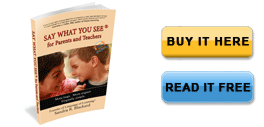Anger CAN DOs

When your child is angry, SAY WHAT YOU SEE (SWYS) sounds like this:
SWYS: “You didn’t like that,” or “You’re really angry!”
Often one objective response is enough to keep you from reacting with anger yourself and to create an opening for your child to communicate more.
One of the main principles of SAY WHAT YOU SEE is that everything children say and do is a communication; and they must continue to communicate until heard. This is human nature; so if a child doesn’t get to express themselves, they will either escalate their actions now or store it up for later. Unheard upsets do not disappear.
Adding CAN DOs helps translate unacceptable words or actions into those that are OK with you. Here’s a sample response to a young child’s anger:
SWYS: “Sounds like you really want me to know how you feel right now, and boy, do I! I can see how angry you are in your face, and I can hear it in your words!”
CAN DO: “Must be something you can do with all that anger. You can tear up these papers (or hit a bop bag or pillow, etc.)!”
If your child would benefit from your presence and continued support, join in and tear them up together. The best moments occur when we can become playful in our interactions with kids.
My older daughter used to bounce off walls to lighten the moment for her younger sister who was mad or crying. Kids know what works for kids.
For a parent, playfully sharing the child’s feelings with an exaggerated mad face and silly words could work as well:
“You are so-o-o-o mad! [Make a mad face, stomp, exaggerate the child’s expression.] I’ll bet you could pop popcorn with your eyes!”
If you do this with humor not sarcasm, your child might join in, and the event could become a “mad” contest. You could even get someone to judge who looks and sounds maddest. In any case, just the simple act of playing when a child expects seriousness can make a huge impact and provide the feeling of a shared experience.
On the other hand, if your child is very serious about their upset, you will want to respond in kind. This would be a child who is trying to prove a point, so the sooner you understand it, the better. [Note: Understanding is not the same as agreeing.]
In either case, when the upset is over make sure to go back and add any STRENGTHs you saw, so your child can draw on them next time:
SWYS: “You were really angry.”
STRENGTH: “It looks like all you needed was a way to express it to calm yourself down.”
SAYing WHAT YOU SEE makes it safe for kids to tell you their side of the story. When they do, listen objectively and SAY WHAT YOU SEE; you’ll be surprised how quickly they make sense.





